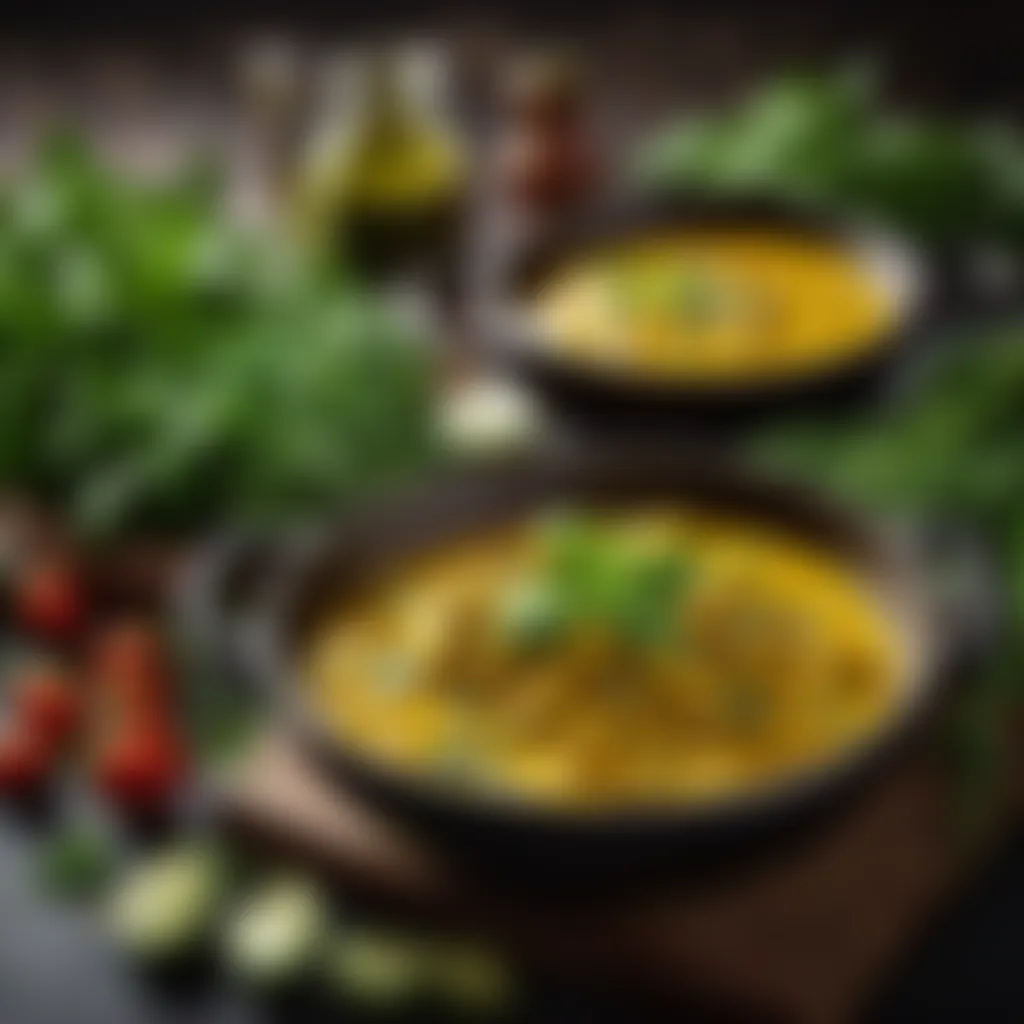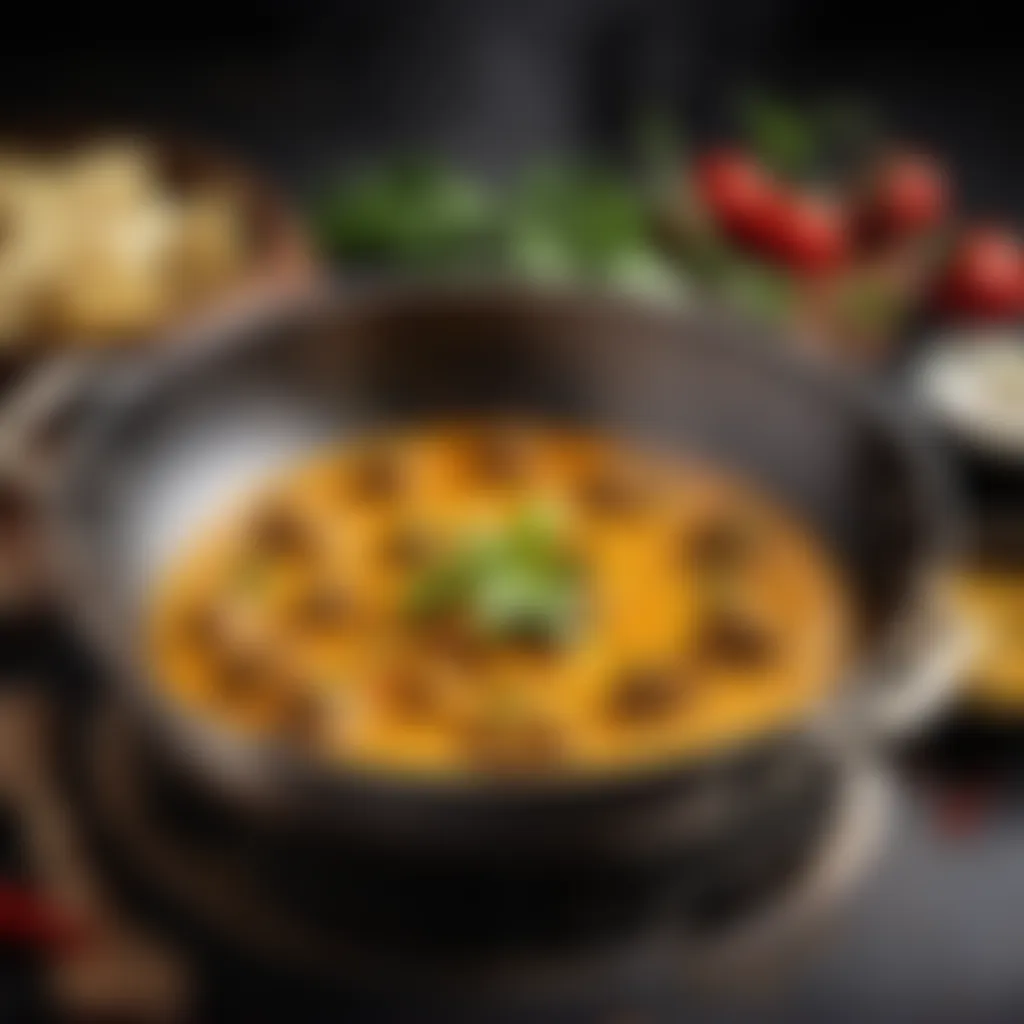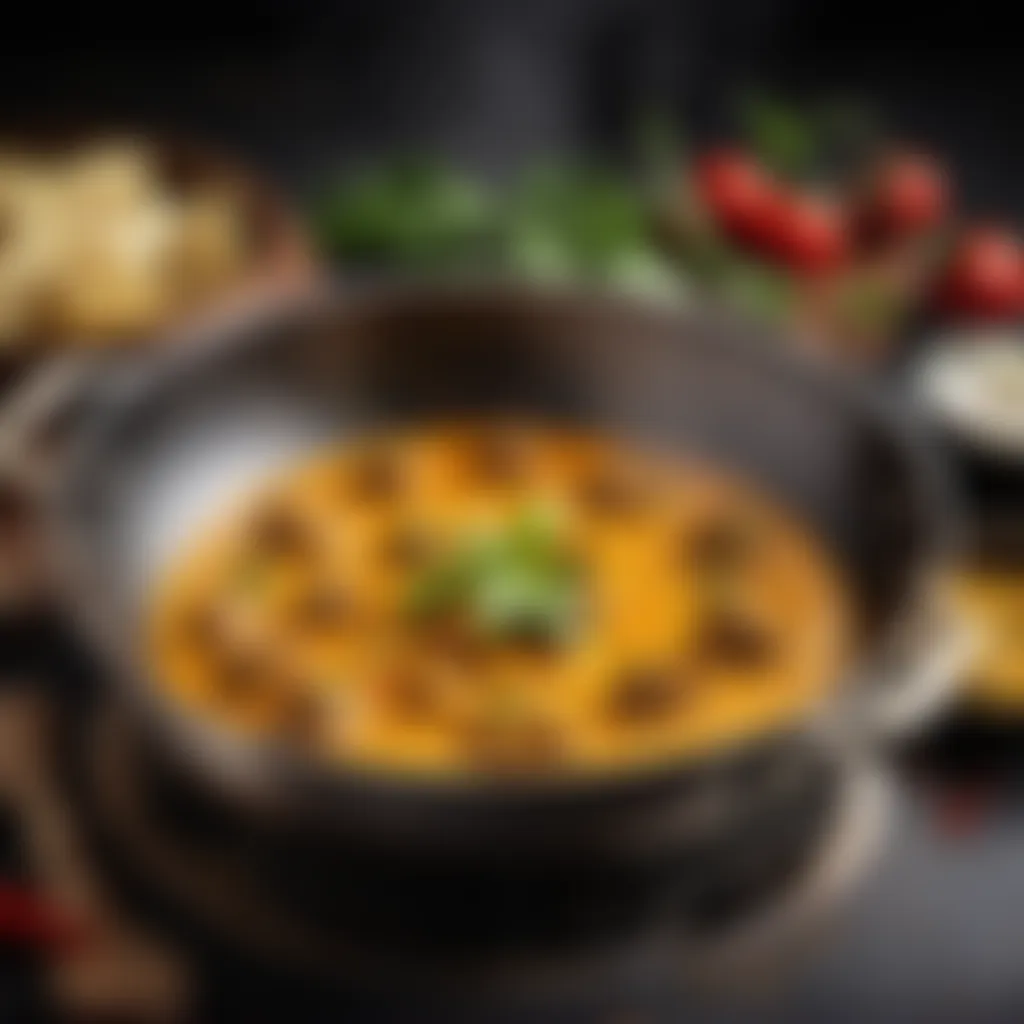Master the Art of Curry Sauce Making


Intro
Curry sauce, an extraordinary blend of flavors, can rejuvenate any simple dish. Whether it’s chicken, vegetables, or even a sumptuous chickpea stew, a well-crafted curry sauce can transform it into a delightful meal worthy of any dining table. One might think that creating the perfect curry sauce is a Herculean task, but it’s really a matter of understanding the essential ingredients, mastering the techniques, and experimenting with regional flavors.
The Journey of Flavor
Historically, curry sauce has deep roots across numerous cultures, especially within South Asian cuisines. Every region boasts its unique spin, from the creamy, coconut-infused curries of southern India to the robust, spicy variants found in northern regions. But no matter the origins, the soul of curry sauce lies in its ingredients and preparation methods. Here, we’ll set the stage by uncovering the crucial components you’ll need for your culinary adventure.
Ingredients:
To kick off this journey, let’s gather the essential ingredients. Here’s a list to streamline your shopping:
- Onions: 2 medium-sized, finely chopped
- Garlic: 4 cloves, minced
- Ginger: 1-inch piece, grated
- Tomatoes: 2 large, pureed (or use a can of diced tomatoes)
- Coconut milk: 1 can (400 ml) for richness
- Vegetable oil: 3 tablespoons (can substitute with coconut oil)
- Curry powder: 2 tablespoons (or depending on your spice tolerance)
- Turmeric: 1 teaspoon
- Cumin: 1 teaspoon, ground
- Chili powder: 1 teaspoon (or adjust based on the heat you prefer)
- Salt: to taste
- Fresh cilantro: for garnishing
- Optional (for variation):
- Lentils or chickpeas: cooked and included for added texture
- Cream or yogurt: to enhance creaminess
Selecting Quality Ingredients
Remember, fresher ingredients lead to a more vibrant sauce. Make the effort to find fresh spices and quality tomatoes, as they act as the backbone for your creation.
Preparation Steps:
Now that we’ve got our troops lined up in the form of ingredients, let’s delve into the detailed instructions for preparation:
- Chop and Prep: Begin by finely chopping the onions. This will form the base flavor for your sauce.
- Mince and Grate: Take garlic and ginger, and either mince or grate them. The fresher, the better!
- Puree Tomatoes: If using fresh tomatoes, blend them until smooth to prepare for the sauce base.
Let’s move on to some technical aspects that’ll be crucial in enhancing your cooking process.
Technical Aspects:
When it comes to achieving the perfect consistency and flavor in your curry sauce, a few technical details are paramount:
- Temperature Settings: Medium to low heat is ideal for developing flavors without burning.
- Timing: Allow each layer of flavor to simmer adequately. Onions generally need about 5-7 minutes until they’re translucent. Follow that with garlic and ginger for about 2 minutes.
- Critical Techniques: When adding dry spices, it’s wise to toast them lightly in oil first. This process often intensifies their flavor profile.
Cooking Process:
Let’s lay out the sequential steps to create your delightful curry sauce:
- Sauté Onions: Heat oil in a heavy-bottomed pot over medium heat. Add chopped onions, sauté until golden brown.
- Add Spices and Aromatics: Toss in minced garlic and ginger. Allow fragrant aromas to rise for about 2 minutes. Add your curry powder, cumin, turmeric, and chili powder, letting them mingle for another minute.
- Incorporate Tomatoes: Pour in your pureed tomatoes. Stir everything together, and let it simmer for around 10-15 minutes until the oil starts to separate.
- Coconut Milk Magic: Slowly mix in the coconut milk. Stir gently until well combined. Allow the sauce to simmer on low heat for another additional 10 minutes.
Troubleshooting Tips:
Every chef encounters hiccups in the kitchen. Here are some common mistakes and how to troubleshoot them:
- Too Spicy: If the sauce ends up being a bit too fiery, a spoonful of sugar or a splash of cream can help balance it out.
- Too Thick: Add a bit of water or stock to your sauce if it’s thicker than you'd like.
- Lacking Depth: Sometimes, it just needs a sprinkle of salt or a squeeze of lemon to brighten the flavors.
By understanding these fundamental aspects, you are not just preparing a sauce; you're crafting an experience. With practice, you’ll find your personal flair emerge in each batch you create, each recipe serving as a canvas for your culinary artistry.
Preface to Curry Sauces
Curry sauces stand as one of the pillars of global cuisine. Their versatility and ability to be tailored to individual tastes make them a prime subject for any culinary enthusiast. In this article, we embark on a journey to understand not just how to make curry sauces, but also to appreciate their rich history and cultural significance.
So, why pay attention to curry sauces? Well, consider the elements involved: the balance of spices, the harmonic blend of sour and sweet, and the sheer delight of creating something that warms the heart and soul. Each sauce serves as a canvas for flavors, opening up a world of possibilities. Whether one prefers a zesty coconut curry or a thick, aromatic masala, understanding the foundations of curry sauce making enriches a cook's arsenal.
With the right guidance, even a novice in the kitchen can whip up a sauce that transports the taste buds to far-off lands. As we delve deeper into this topic, we will not only explore the methods of crafting exceptional curry sauces but also provide insight into common pitfalls to avoid, tools needed, and regional variations that reflect the diverse nature of culinary traditions.
Historical Context
Curry sauces have roots that dig deep into history. The term "curry" itself likely stems from the Tamil word kari, which means sauce. Originating from South Asia, particularly India, the use of spices in cooking can be traced back thousands of years. As trade routes expanded, so did the knowledge and application of these complex flavors.
Cultural interactions during the British colonial period further spread curry, adapting it to local tastes. For instance, the introduction of British curry powder blended European and Indian cooking styles into dishes like Chicken Tikka Masala. These exchanges signify that curry sauce making is not merely a culinary practice but a narrative of globalization and adaptation.
Cultural Significance
Curry sauces represent a tapestry of cultural identity and expression. In many cultures, curry is a communal dish, shared among family and friends, symbolizing togetherness. Each culture imbues its own character into the curry, illustrating local ingredients and traditions.
For example, while Indian curries might favor robust spice blends, Thai curry exemplifies herbs and fresh ingredients, resulting in brighter, more aromatic flavors. Thus, making a curry sauce is more than unlocking a recipe. It provides insight into the heart of a community’s culinary heritage.
In essence, each curry sauce tells a story. Through flavors, it expresses history, migration, and the melding of cultures. By mastering the art of curry sauce making, one doesn’t just elevate a dish but also connects with a rich, interwoven narrative that spans continents and centuries.
Understanding Ingredients


When it comes to crafting memorable curry sauces, understanding the ingredients that go into them can be the difference between an ordinary dish and an extraordinary one. Each component, whether it’s a spice, herb, or a protein, adds its distinctive flair and depth to the sauce. Knowing how to use these elements effectively is essential for anyone looking to develop their culinary skills. Ingredients don’t just play a role in flavor; they tell a story, and learning their nuances can guide you in making adjustments as you progress.
Essential Spices
Turmeric
Turmeric is not just another pretty spice; it's truly the golden child of the spice rack. This bright yellow powder adds a distinct earthy flavor to curry sauces. Its main active compound, curcumin, gives it anti-inflammatory properties, making it a boon for health enthusiasts. Turmeric's key characteristic is its vibrant color, turning your curry a lovely shade of yellow and making it visually appealing. What’s more, it melds wonderfully with other spices, enhancing their flavor profiles. Just remember, a little goes a long way; too much can make things a tad bitter rather than pleasant.
Cumin
Ah, cumin! This spice is like the trusty friend in your cooking journey. Its nutty, warm flavor brings a robustness that’s hard to beat. Cumin is particularly popular in many curry recipes because it adds complexity without overpowering other ingredients. A stand-out feature of cumin is its aroma; toasting it can release its essential oils, providing an even richer base for your curry sauces. However, be cautious not to let it burn, as that can lead to a bitter edge that no one wants.
Coriander
Coriander, with its citrusy notes, often gets cast as the sidekick to spices like cumin and turmeric. But don’t underestimate it! This spice can transform a dish with its freshness. Coriander seeds, when crushed, provide a unique balance that helps to ‘lift’ heavy flavors, making it a smart choice in curry. It shines in both whole and ground forms. However, its flavor can be lost if exposed to heat for too long, so it’s typically added toward the end of cooking.
Herbs and Their Roles
Cilantro
Cilantro, or coriander leaves for some, adds bright, fresh notes to your curry. Many find its flavor polarizing; some love it, while others loathe it. Regardless of personal preference, it’s hard to deny that adding fresh cilantro at the end of cooking can elevate the dish. Its lightness cuts through rich flavors, refreshing the palate. The downside, however, is that cilantro loses its punch quickly after being chopped, so it’s best used fresh right before serving.
Fenugreek
Fenugreek might not be the most straightforward herb to come by, but its caramel-like sweetness and slightly bitter undertones make it a worthy addition. This herb is often used in Indian cooking and can bring warmth and depth to your curry sauces. It’s especially valued for its notable aroma. However, be cautious—too much fenugreek can dominate the dish, so use it sparingly.
Mint
Mint is a breath of fresh air in the world of curry. Its refreshing and slightly sweet flavor can provide a delightful contrast to rich curries. Whether used in chutneys or as a garnish, fresh mint can brighten the entire dish. One thing to keep in mind is that mint can overshadow other flavors if used excessively, so it’s best to sprinkle just enough to let its aroma shine without becoming overpowering.
Cooking Bases
Onion
Onion serves as the backbone of many curry sauces, bringing both sweetness and umami. When caramelized, it transforms into a golden-brown delight that deepens the sauce's flavor profile. Onions can be used in various stages of cooking; they can be a base, simmered, or used as a final touch for crunch. However, overcooking them can lead to bitterness; it’s a fine balance but quite rewarding if achieved.
Tomato
Tomatoes add acidity and sweetness, making them another fundamental aspect of curry sauces. The sheer versatility of tomatoes is staggering; whether using fresh, canned, or pureed, they can thicken your sauce while enhancing its color and flavor. They also help to bring all spice components together in harmony. Just watch their cooking time—overcooked tomatoes can turn overly sweet and lose their character.
Coconut Milk
Coconut milk is a beloved ingredient, particularly in Thai cuisine. Its creamy texture adds richness to curry sauces, transforming an ordinary dish into an indulgent experience. The distinct flavor aautomatically introduces a tropical note that can contrast beautifully with spices. However, it's essential to choose full-fat coconut milk for the best results, as lighter versions can lack the requisite creaminess and taste.
Protein Choices
Chicken
Chicken is often the go-to protein for many curry lovers. Its mild flavor allows it to absorb the complex spices in your sauce, making each bite delightful. With various cooking methods—whether roasting, stewing, or grilling—chicken remains versatile; it can work with a myriad of sauces. One potential downside is the cooking time. Different cuts require different approaches; if undercooked, it can be a health risk.
Lentils
Lentils have become increasingly popular as a protein option for their health benefits. They are rich in fiber, making them a filling and nutritious choice. Their ability to absorb flavors makes them an excellent vehicle for spices. Moreover, cooking lentils can be quite forgiving; they don’t require precise timings. But note that lentils can disintegrate if overcooked, losing their textural integrity.
Tofu
Tofu is certainly a superstar in vegetarian cooking. Its ability to soak up flavors is unmatched, giving dishes a subtle but satisfying umami kick. Tofu comes in different types—firm, soft, and silken—each serving a different purpose in curries. A downside is its texture, which can sometimes be mushy if not pressed properly. Additionally, it’s essential to use firm or extra-firm varieties in curry dishes to maintain shape and integrity.
Understanding the ingredients not only plays a pivotal role in flavor management but also can significantly enhance the enjoyment of your curry cooking experience. Look carefully at each element and consider how they interact. This will go a long way in creating that perfect curry sauce.
Tools for Making Curry Sauce
Crafting an authentic curry sauce isn't just about the ingredients; it’s equally about the tools you use. Having the right equipment can elevate your cooking experience and ensure that each element is executed perfectly. Quality tools help with precision, efficiency, and ultimately, the flavor of your dish.
Whether you are a novice or an experienced cook, the right kitchen utensils and apparatus are essential to achieving that flavorful and aromatic sauce you aim for. Let’s break down the key tools and their significance in crafting beautiful curry sauces.
Essential Kitchen Utensils
Knives
When it comes to cooking, a good knife is like a painter's brush; it's critical for achieving the desired effect. A sharp chef's knife, for instance, makes chopping onions and vegetables effortless, allowing you to focus more on the flavors rather than struggling with dull blades.
- Key Characteristic: A chef's knife is versatile, making it ideal for various cutting tasks. It typically features a broad blade that curves upward for rocking cuts, which can save time while giving you knife skills a good workout.
- Benefits: The right knife can drastically reduce prep time and enhance the texture of your ingredients, contributing to the overall flavor of the curry.
- Unique Feature: High-carbon stainless steel options offer lasting sharpness and durability, though they can be more expensive and require regular maintenance to prevent rusting and dulling.


Cutting Boards
Cutting boards play an understated but essential role in the kitchen. A good board provides a sturdy surface for your chopping without damaging your knives. You might have heard it said, "A craft is only as good as its tools," and this applies here too.
- Key Characteristic: They come in various materials, like wood, plastic, or bamboo. Each has its own benefits, with wood being gentle on knife edges and plastic being easy to clean.
- Benefits: Investing in a quality cutting board can prevent cross-contamination and support food safety—a must-have when prepping fresh vegetables or proteins.
- Unique Feature: Bamboo boards are eco-friendly and possess natural antibacterial properties, while glass boards can look great but can be harsh on knife edges, possibly causing issues in the long run.
Measuring Cups
Accuracy in cooking can’t be overstated, and that’s where measuring cups come into play. All those spices and liquids require precise quantities to balance flavors effectively—and nobody likes a mishmash of ingredients that don’t quite fit together.
- Key Characteristic: Measuring cups come in sets designed for both liquid and dry ingredients, often having clear markings for easy reading.
- Benefits: They take the guesswork out of measuring, allowing you to replicate your best curry sauce time after time.
- Unique Feature: While metal measuring cups are durable, glass measuring cups offer a transparent design that allows you to see the contents, which is particularly handy when measuring liquids like coconut milk.
Cooking Apparatus
Pots and Pans
Your choice of pots and pans greatly influences how evenly your sauce cooks. A heavy-bottomed pot conducts heat well, preventing hotspots that can scorch your precious sauce.
- Key Characteristic: Look for pots made from materials like stainless steel or cast iron, as they provide robustness that stands the test of time.
- Benefits: Properly rated cookware contributes to making sauces that simmer slowly, allowing all the flavors to meld together beautifully.
- Unique Feature: Cast iron retains heat exceptionally well but requires some extra care to maintain its seasoning. While non-stick pans are easy to clean, they may not provide the same flavor depth as their stainless counterparts.
Blenders
Incorporating a blender into your curry-making regime can be a game changer. Perfect for pureeing and combining sauces to achieve that silky texture, blending ensures every spoonful is imbued with intense flavor.
- Key Characteristic: Powerful blenders can easily handle fibrous ingredients, making them ideal for curry bases packed with vegetables.
- Benefits: Using a high-speed blender can emulsify ingredients quickly, saving you time and effort while enhancing the overall mouthfeel of your sauce.
- Unique Feature: Some models even feature pre-set programs for soups and sauces, ensuring optimal blending for a foolproof outcome.
Spice Grinders
Nothing compares to the freshness of grinding your own spices right before cooking. A spice grinder opens a whole new flavor dimension, allowing your curry to burst with authentic aromas.
- Key Characteristic: Handheld or electric spice grinders are both viable options, but electric ones can save time, especially when dealing with larger quantities.
- Benefits: Grinding spices just before using them releases essential oils, dramatically improving the flavor profile of your curry sauce.
- Unique Feature: A good spice grinder can also double as a coffee grinder, making it a valuable addition to your kitchen arsenal.
In summary, the tools of the trade are not only vital for preparing a delicious curry sauce but also enrich the cooking experience itself. Investing in quality utensils and apparatus pays off in flavor, safety, and enjoyment, overcoming the challenges of curry sauce making effectively.
Techniques for Crafting Curry Sauces
When it comes to curry sauce making, the techniques employed are what truly separate a home cook from a master of the craft. Mastery in these techniques not only allows for the creation of mouthwatering sauces but also elevates the entire culinary experience. The art of crafting curry sauces involves an intricate dance between flavors and textures, which can turn a simple dish into something extraordinary. Understanding the specific elements, benefits, and considerations of these techniques is crucial for anyone looking to refine their curry skills.
Sautéing and Building Flavor
Sautéing is often the foundation upon which great curries are built. This technique involves cooking ingredients quickly in a hot pan with a small amount of oil, which helps to release essential oils and intensify flavors. A common starting point is to sauté onions until they’re translucent and aromatic. This initial step lays the groundwork for layering complex flavors, as the caramelization of sugars gives the sauce a depth that is simply unmatched. By incorporating spices during this phase, you can toast them lightly, unlocking their full potential and infusing the oil with their richness. This is key in creating a flavor-packed curry sauce that lingers on the palate.
Layering Ingredients
Once the sautéing phase is complete, layering ingredients plays a pivotal role in developing a well-balanced curry sauce. Here, the order in which ingredients are added can significantly affect the final taste. Introducing spices such as cumin and coriander earlier in the process allows them to meld beautifully with the base. As a general rule, heavier ingredients like tomatoes or coconut milk should follow, as they help to create a luxurious body without overshadowing the spices. This harmonious layering leads to a complex flavor profile that feels cohesive rather than disparate, which is essential for successful curry making.
Balancing Ingredients
Achieving balance in flavors is paramount in curry sauce preparation. Here, we face the challenge of controlling and harmonizing various flavor components to produce a well-rounded dish.
Tasting and Adjusting
Tasting and adjusting your curry sauce as you go is an essential skill. This process is about more than just ensuring the sauce is adequately seasoned. It invites innovation; by tasting frequently, you can identify areas for enhancement or adjustment. For instance, if the heat from chilies is overwhelming, a pinch of sugar or a splash of cream can mitigate the spiciness while enriching the sauce. This dynamic nature allows the cook to tailor the dish to suit their palate or that of their family. Tasting becomes an exploratory journey, revealing the unique character of each ingredient as they meld together.
Acidity and Sweetness
The balance of acidity and sweetness is another cornerstone of making a delightful curry sauce. An ideal curry will often have a touch of acid, like lemon juice or vinegar, which brightens the overall flavor, making the dish feel fresh and vibrant. Sweetness, whether it’s derived from carrots, tomatoes, or a dash of sugar, can provide the necessary counterpoint to acid, helping to harmonize the dish. Together, they create layers of flavor that can transform a standard curry into a culinary masterpiece, making this balance a crucial consideration in the recipe.
"A well-balanced curry sauce is like a symphony; every ingredient contributes its notes, creating a flavorful harmony."
Understanding the importance of these techniques gives housewives and culinary enthusiasts alike the ability to create satisfying curry sauces that delight both the eyes and the palate.
Regional Variations of Curry Sauce
Curry sauces are not just a universal concept; they come with layers of cultural richness that reflect the regions they hail from. Understanding these variations can significantly elevate your culinary skills. By diving into regional nuances, you gain insight not only into the different flavors and ingredients but also into the stories and traditions behind them. This ehm, enriches your cooking and gives it a deeper personal touch, making every dish you create a homage to its origins.
Indian Curry Sauces
Butter Chicken
Butter Chicken is more than just a dish; it’s iconic in Indian cuisine. Born in Delhi, this creamy delight has fans across the globe. At its heart, Butter Chicken boasts a luscious tomato-based sauce flavored with a delicate mix of spices. It’s often enriched with cream, giving it a smooth and velvety texture.
The key characteristic of Butter Chicken is its balance of rich savoriness with a hint of sweetness, achieved through generous use of tomatoes and the mild spice blend. This makes it an appealing option for those who may be a bit wary of intensely spiced dishes.
However, while it’s much beloved, the richness can overwhelm if paired thoughtlessly. When planning, keep portions in check and perhaps offer some bread or rice to balance the meal.


Paneer Tikka Masala
Paneer Tikka Masala is a vegetarian favorite that stands tall in the pantheon of Indian curries. The star of the dish is paneer – Indian cottage cheese – which gets marinated in spices and yogurt before being grilled to perfection. The vibrant sauce, often tomato-based as well, is fragrant with ground spices like garam masala.
The unique feature of Paneer Tikka Masala lies in the smoky notes imparted during grilling, which impart a depth of flavor that marry beautifully with the sauce. Its big appeal is its versatility, fitting effortlessly into vegetarian meal plans.
While this dish shines brightly, achieving a balance is key. If the marination is too intense or the sauce is too oily, it risks overshadowing the delicate flavors of the paneer.
Thai Curry Sauces
Green Curry
Green Curry, or "Gaeng Khiao Wan", is a delightful explosion of fresh herbs and spices, primarily green chilies and basil. This haste curry captures the essence of Thai cuisine beautifully. The fresh ingredients bring a distinct brightness that sets it apart from other curries.
The standout feature of Green Curry is its vibrant color and herb-intensive flavor profile. It’s perfect for those who prefer a punchy flavor that doesn’t come from over-processed sauces. This dish works wonders with chicken, beef, or tofu, making it uniquely adaptable.
That said, it does require careful sourcing of fresh ingredients, which can be a hurdle in some areas, limiting its accessibility to aspiring cooks.
Massaman Curry
Massaman Curry is often considered a melting pot of culinary traditions. With influences that span across Indian, Persian, and Malay cuisine, this blend is not to be underestimated. It leans toward the milder side compared to other Thai curries, often made with potatoes and peanuts, creating a more earthy, comforting dish.
The key characteristic of Massaman Curry is its richness due to the inclusion of both coconut milk and roasted spices. It’s like a warm hug in a bowl. This makes it a favorite for those seeking heartier fare, particularly with lamb or beef as the protein choice.
However, making a successfully balanced Massaman can sometimes be tricky. Too much sweetness can mask the spice, thus careful measurement becomes essential in preparation.
Caribbean Curry Sauces
Jerk Chicken
Jerk Chicken is less of a sauce and more of a technique, but its placement in this section is well-earned. Originating from Jamaica, this dish showcases a unique marinade that includes allspice, thyme, and Scotch bonnet peppers. It’s grilled to perfection, imparting a smoky flavor that is simply irresistible.
The key to Jerk Chicken is in that true Jamaican spice rub. This dish embodies the spirit of Caribbean cooking with its lively flavors and heat. It’s a hit at gatherings, making it a fabulous addition to any backyard barbecue.
However, one must tread lightly. The heat can be quite overwhelming for those unaccustomed to spicy foods, potentially alienating some eaters.
Curried Goat
Curried Goat is a traditional dish in Jamaica and reflects the deep cultural influences of the island. This dish is simmered slowly, allowing the goat meat to become tender while absorbing aromatic spices and herbs.
The unique aspect of Curried Goat lies in the time it takes to cook it, contributing to a profound depth of flavor that is hard to match. It’s an expertly balanced option for meat lovers who appreciate bold flavors.
However, it can be a challenging dish to master; if not cooked with care, the goat can be tough and uninviting. Proper marination and slow cooking techniques are essential to achieve the desired result.
Common Mistakes in Curry Sauce Making
Crafting the perfect curry sauce is as rewarding as it is challenging. In this section, we focus on some common missteps that can sabotage a seemingly well-thought-out recipe. Understanding these pitfalls not only helps enhance your cooking skills but also elevates the flavor and texture of your curry sauce. The details discussed here are crucial for anyone aiming to make a memorable dish at home.
Under or Over Spicing
One of the most frequent issues in curry sauce making is getting the spice balance wrong. Too little spice leaves the sauce bland, while an overzealous hand can turn it into an unbearable heat festival. Spices such as cumin, coriander, and turmeric each have their own strengths. When measured correctly, they complement each other beautifully, but their power can quickly spiral the dish out of control.
To avoid this:
- Start small: If you're new to spices, begin with less than what the recipe calls for. You can always add more during the cooking process.
- Taste as you go: This is a cardinal rule in cooking, but especially with spices. Every palate is unique, so adjust accordingly based on your personal preference.
- Consider the source: Fresh spices enhance flavor. If your spices have been sitting in the cabinet for ages, they might not pack the punch you expect.
Improper Cooking Times
Cooking times are another area where many home cooks fumble. Whether it's vegetables, proteins, or even the sauce itself, timing can make or break the dish. A curry too hastily cooked could lead to undercooked proteins or overly mushy vegetables, compromising both texture and flavor.
Here are some tips to keep on the right track:
- Follow the recipe: Even experienced cooks should respect cooking times. They are often based on how flavors develop best.
- Use a timer: It may seem trivial, but setting a timer while cooking can save you from unpleasant surprises.
- Learn to judge: With practice, you'll pick up on signs that indicate doneness, like the aroma or the sound of simmering ingredients.
Neglecting Balance
When preparing curry sauce, achieving balance is essential. This relates not just to spices, but to flavors overall. A successful curry is a harmonious blend of heat, sweetness, and acidity.
Some common mistakes include:
- Forgetting sweetness: A hint of sugar or honey can do wonders in countering the heat of spices. It’s like a cool breeze on a hot day.
- Ignoring acidity: Ingredients like lime juice or tomatoes can brighten up the dish. A splash at the end often helps to elevate the entire flavor profile.
- Fat content: Coconut milk or cream can enrich the sauce, providing a creamy texture that binds the flavors together. Skipping this can leave your curry feeling flat.
"The magic of a great curry lies not just in the spices or the procedure, but in how well the flavors work together. It's the culinary equivalent of music, where each note contributes to a symphonic whole."
As you explore the art of curry sauce making, keeping an eye on these common mistakes will set you up for success. With practice and a watchful eye, you can avoid these blunders and create rich, flavorful dishes that truly impress.
The End: Evolving Your Curry Sauce Skills
As we wrap up this extensive guide on curry sauce making, it’s essential to underline that mastering this culinary art form is a journey—a voyage steeped in exploration, experimentation, and enjoyment. The world of curry sauces is vast and colorful, much like the spices we use. With practice, one can elevate their sauce-making skills to create dishes that are not only palatable but memorable.
Encouraging Experimentation
To truly grasp the essence of curry sauces, you must embrace the concept of experimentation. This doesn’t just involve following recipes to the letter but rather understanding the harmony of flavors and ingredients. Stirring up a new batch of curry sauce means diving into your pantry and seeing what tickles your fancy.
Start with small modifications—perhaps swap out a spice or try a different cooking base. Love the warmth of turmeric? Maybe mix in some smoked paprika for a twist. Find inspiration from what you have at hand: old recipes from family, diverse culinary traditions, or even fusion ideas. The unexpected combinations might just lead to your new favorite dish.
"Cooking is like love; it should be entered into with abandon or not at all." – Harriet Van Horne
To motivate yourself, keep a journal of your curry creations. Note what works, what doesn’t, and how you felt about each dish. A systematic approach can help refine your skills even more, as you track progress and learn from missteps. Each mishap is simply a stepping stone to crafting the perfect sauce.
Resources for Further Learning
The culinary world is brimming with resources that can help deepen your understanding and skills when it comes to curry sauce making. Here’s a brief list of some invaluable tools:
- Books
- Online Platforms
- Cooking Classes
Look into local cooking schools or community centers that offer curry classes. Here, you can also gain new perspectives by interacting directly with instructors and peers.
- The Curry Guy by Dan Toombs - This book is an excellent guide with traditional and modern recipes that breathe life into the kitchen.
- Indian-ish: Recipes and Antics from a Modern American Family by Priya Krishna - A fusion of Indian flavors packed into easy-to-follow recipes.
- Reddit: r/IndianFood - A community where food lovers share recipes, tips, and takeaways from their cooking experiences.
- Wikipedia - Offers a broad overview of curry, its history, and regional variations that can inspire your cooking.







